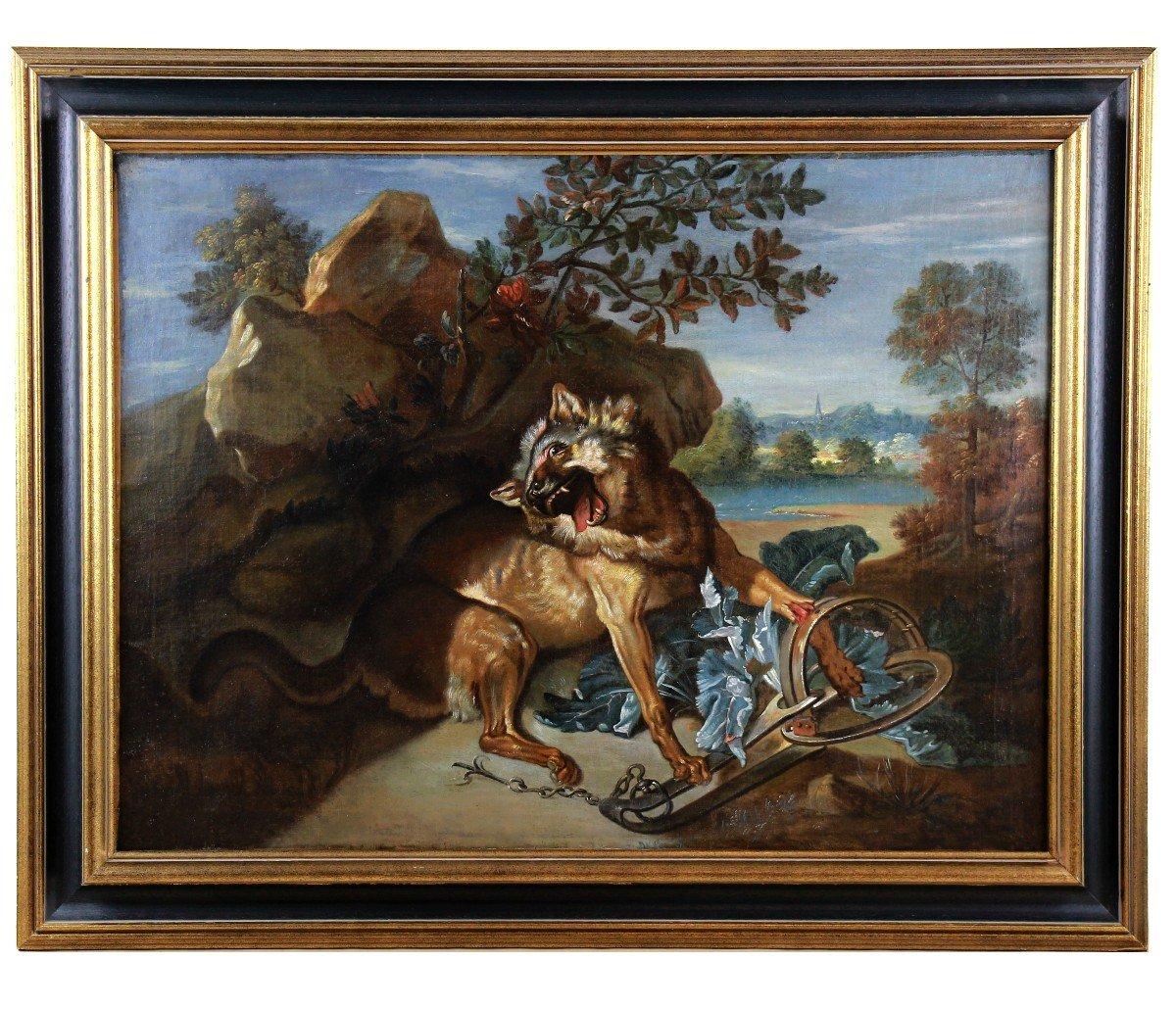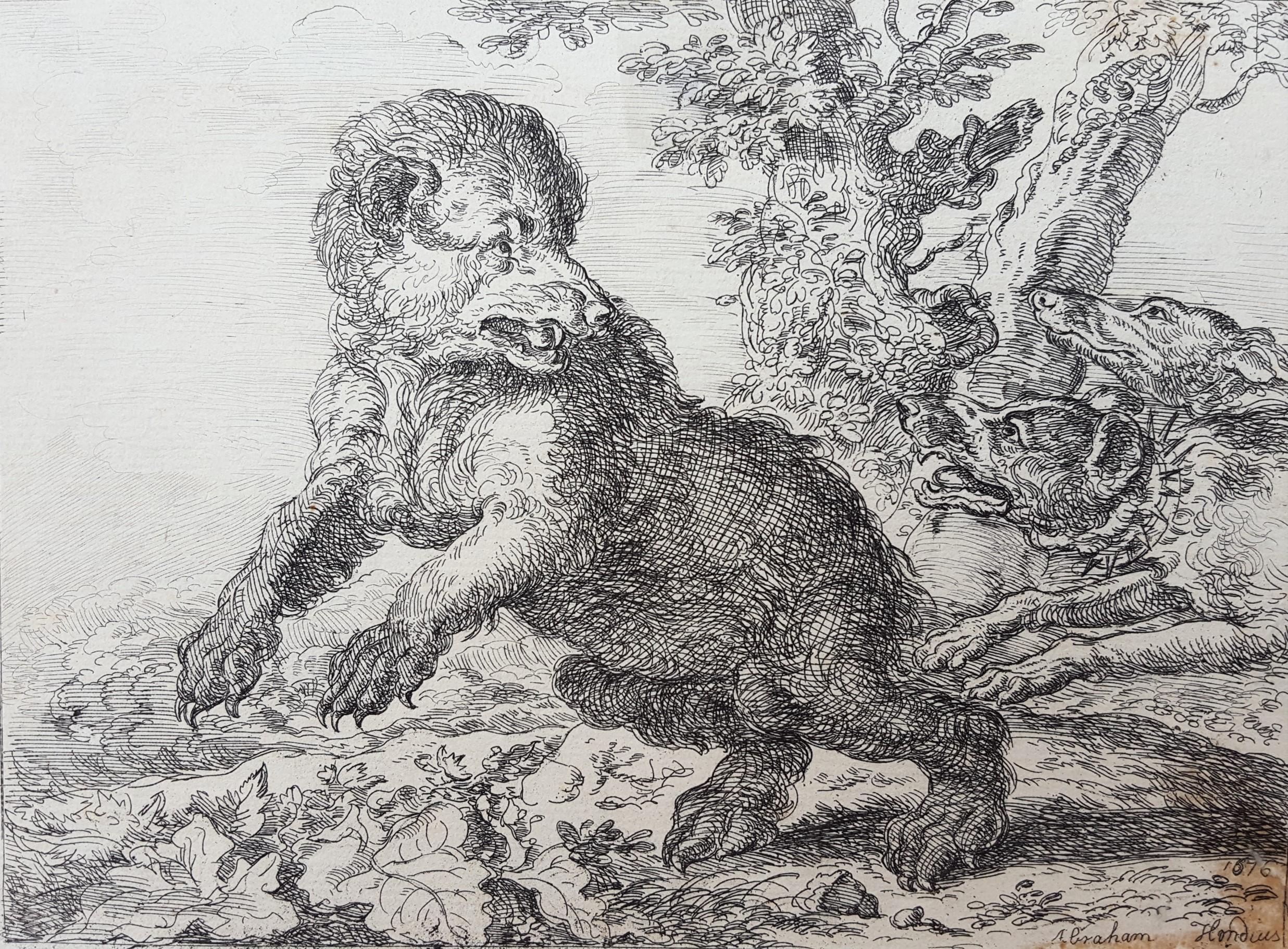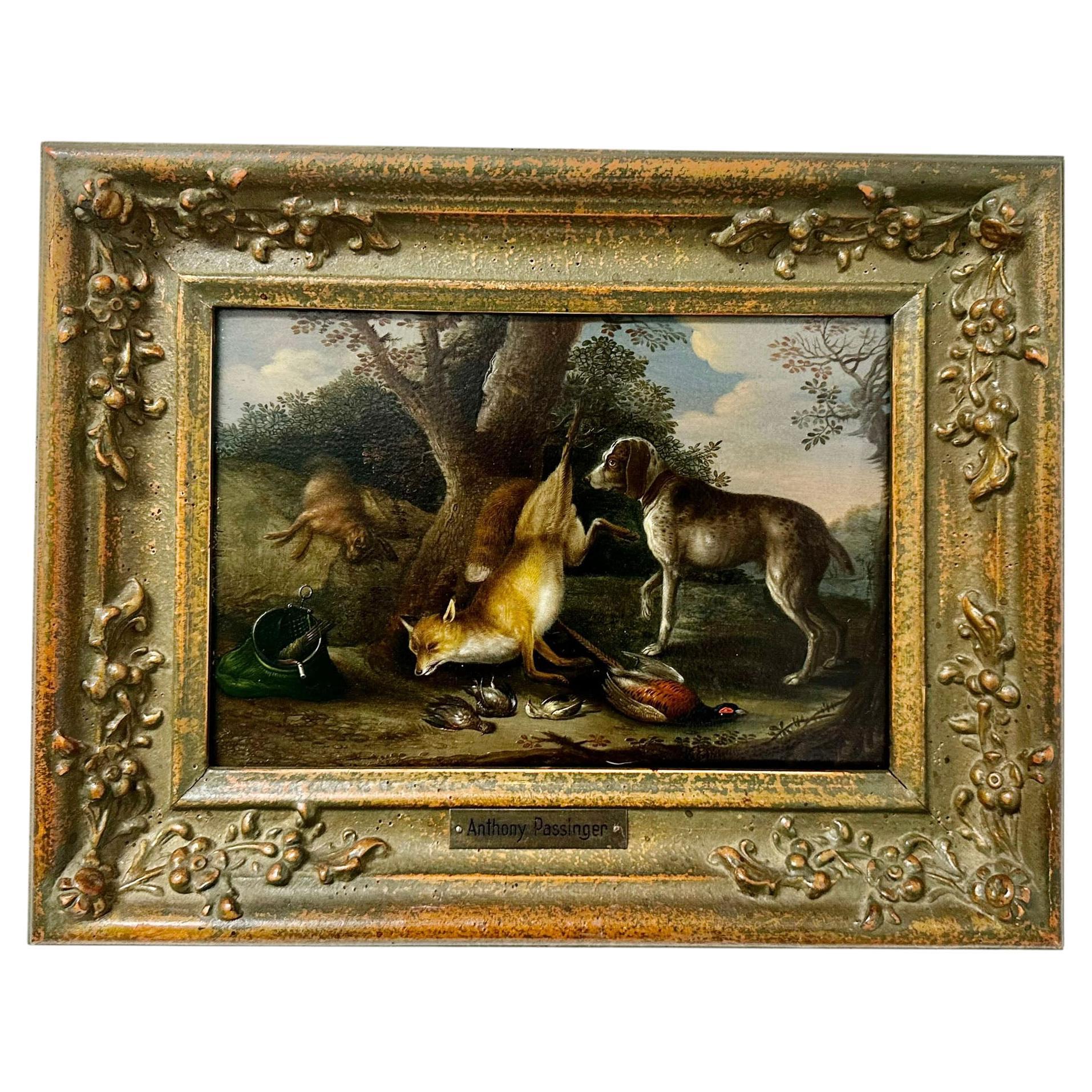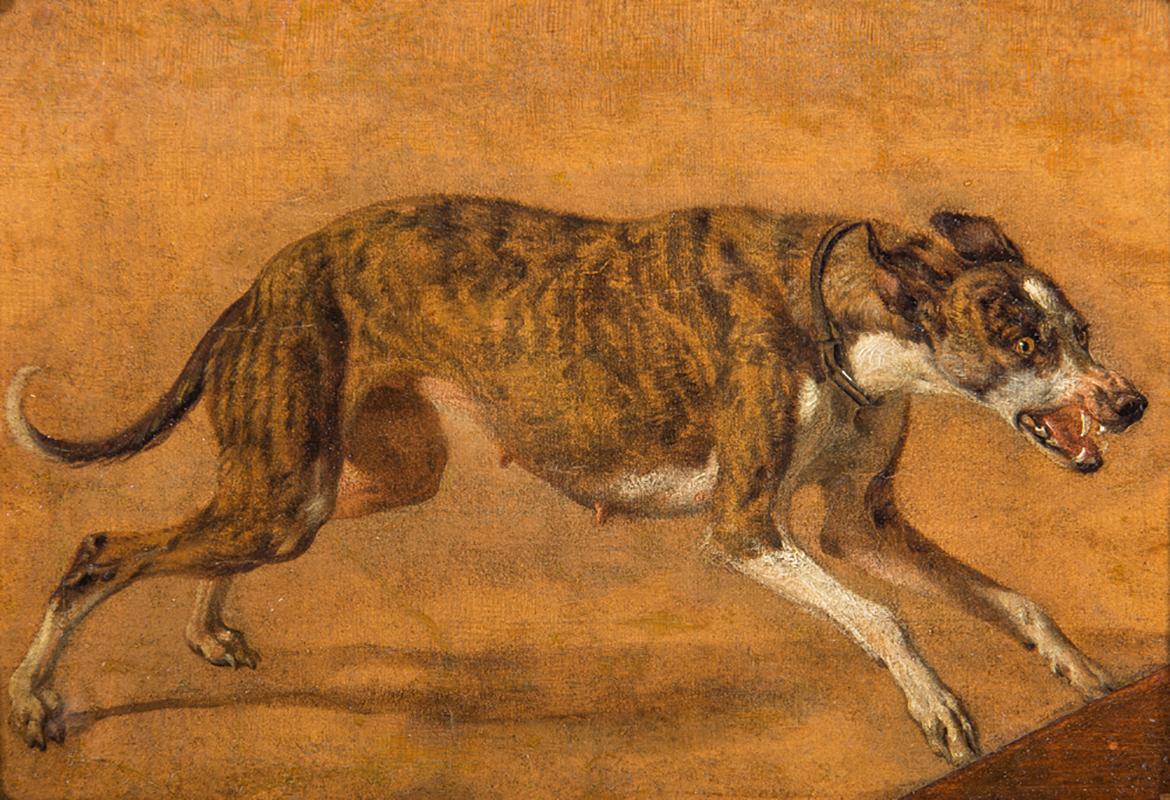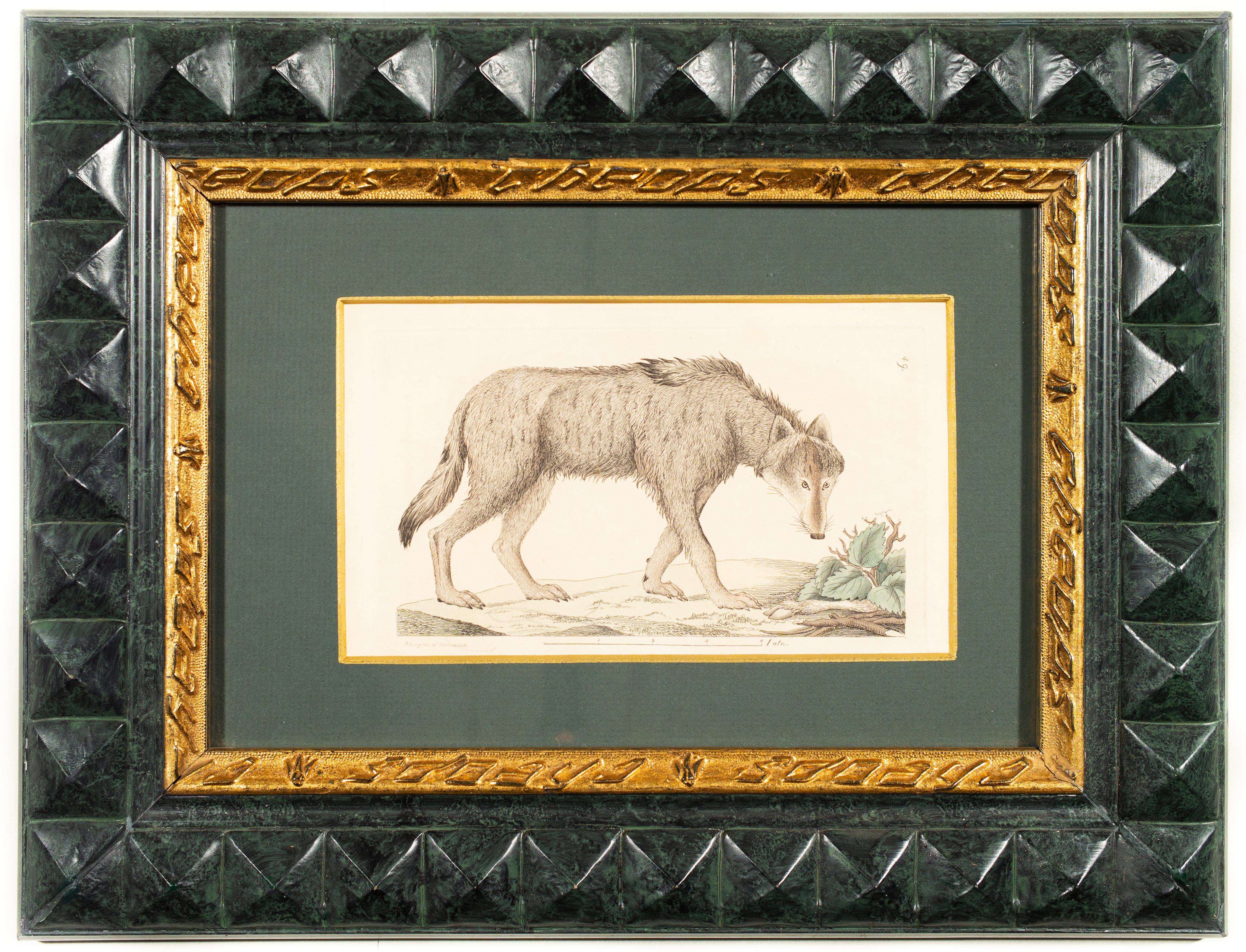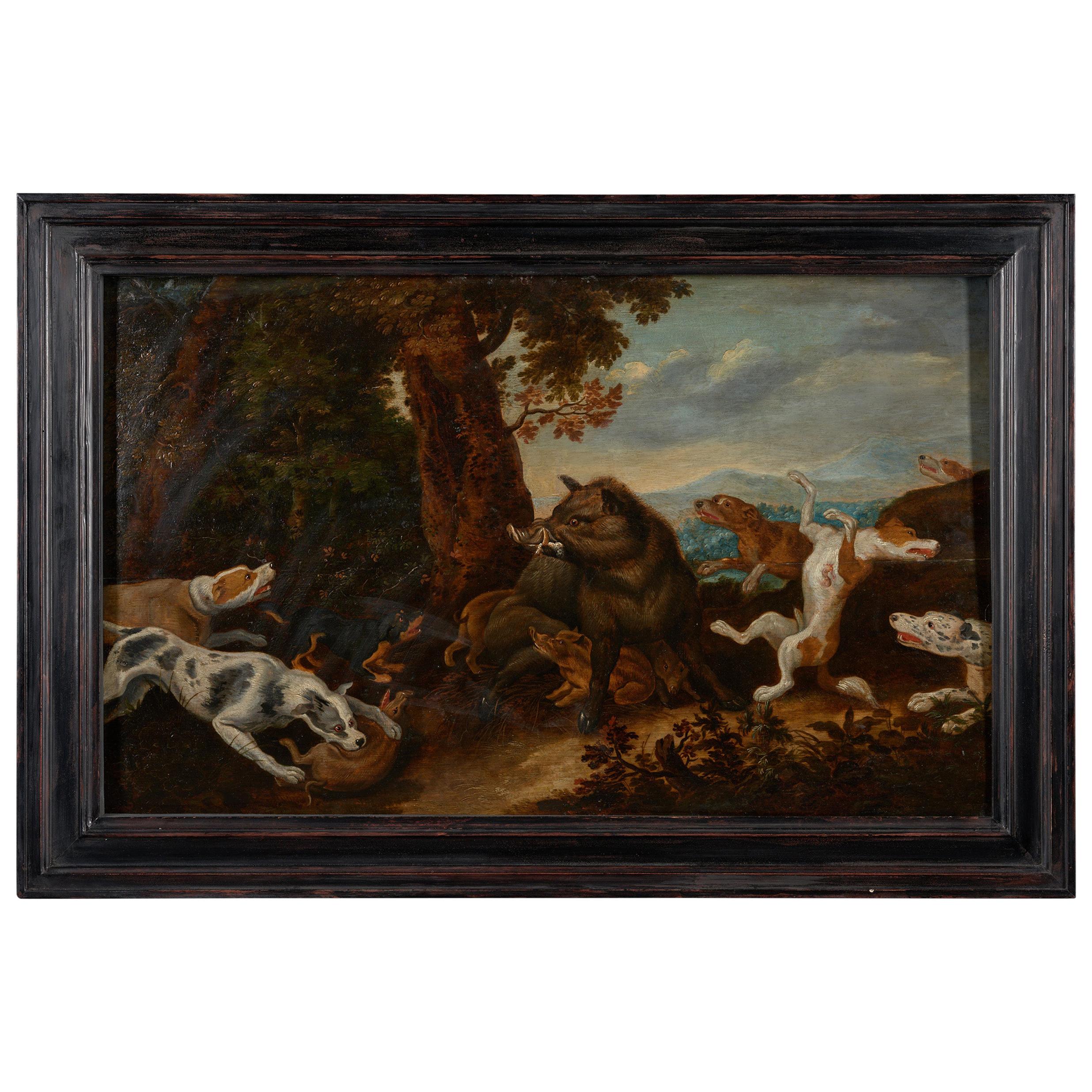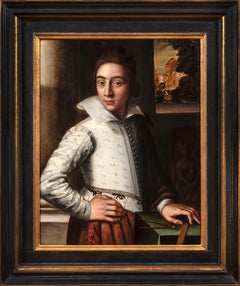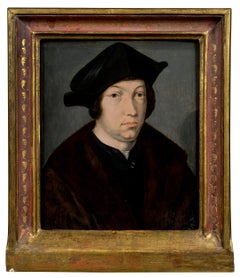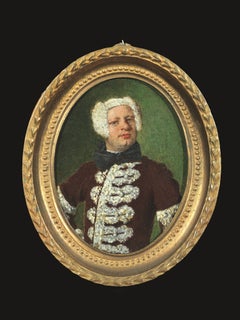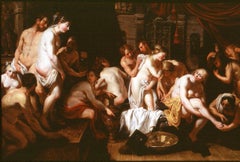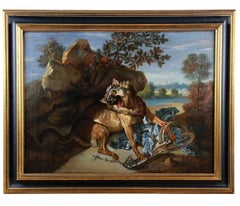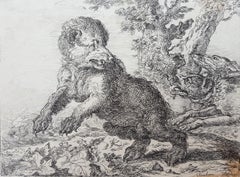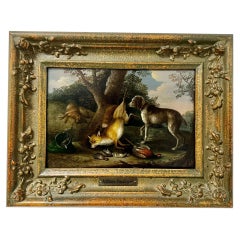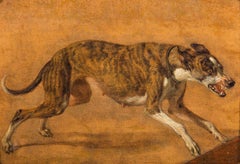Items Similar to A Wolf
Want more images or videos?
Request additional images or videos from the seller
1 of 2
Carl Borromäus Andreas RuthartA Wolf
$85,000
£64,188.61
€73,490.04
CA$120,042.22
A$131,057.37
CHF 68,708.02
MX$1,591,742.21
NOK 858,051.26
SEK 810,229.19
DKK 548,524.89
About the Item
Provenance:
The Marchesi Strozzi, Palazzo Strozzi, Florence
Sale, Christie’s, London, May 20, 1993, lot 315, as by Carl Borromaus Andreas Ruthart, where acquired by:
Private Collection, New York
Ruthart has been called one of the most intriguing artistic personalities of seventeenth-century Europe. He was born and trained in Danzig, before visiting Rome in 1659. From 1663 to 1664 he was in Antwerp, registered in the painter’s guild as “Carlo Routtart,” where he studied Flemish animal painting, especially the work of Jan Fyt and Frans Snyders.
Ruthart specialized in the depiction of animals—in particular, wild animals—at rest, in conflict, fighting, and being hunted. His grander compositions incorporated them into the surrounding scenery, as well as depicting them in idyllic settings, in mythological, and in biblical contexts. Ruthart had a superb understanding of animal anatomy and was adept at depicting animals in motion and at rendering fur with astonishing fidelity. His work is characterized by restrained, cool colors (silver-grey and brown for rocks, blue-green for vegetation and vivid colors for the animals themselves).
In the 1660s Ruthart travelled through Regensburg to Vienna, where he worked for Prince Charles Eusebius of Liechtenstein. In 1672 he was in Venice and Rome, where he saw the work of Giovanni Battista Castiglione. That year he entered the Celestine monastery in Rome and painted altarpieces for the monastery church of S Eusebio. He later moved to the Abbey of S. Maria di Collemaggio in L’Aquila, where he was known as “Pater Andrea” and where he remained until his death.
Paintings by Ruthart are to be found in princely collections and museums across Europe, but the largest holding of the artist’s work remains in L’Aquila, exhibited in the Sala Carlo Ruther of the Museo Nazionale d’Abruzzo. A group of Ruthart’s oil studies of animals from life were retained by the artist and utilized by him throughout his career as references for his larger compositions. Nine superb examples passed to the collection of the Marchesi Strozzi in Florence and were dispersed at auction in 1993. The present study of a wolf is one of these. It was used by Ruthart in several compositions, including The Fable of the Fox and the Sick Lion (Galleria Nazionale, Rome), Ulysses and Circe of 1666 (formerly, Dresden Gemäldegalerie), and in the lower left of the signed Wild Animals in a Mountain Gorge (Nationalmuseum, Stockholm), illustrated below.
- Creator:Carl Borromäus Andreas Ruthart (1630 - 1703)
- Dimensions:Height: 9 in (22.86 cm)Width: 11 in (27.94 cm)
- Medium:
- Movement & Style:
- Period:
- Condition:
- Gallery Location:New York, NY
- Reference Number:1stDibs: LU1026198482
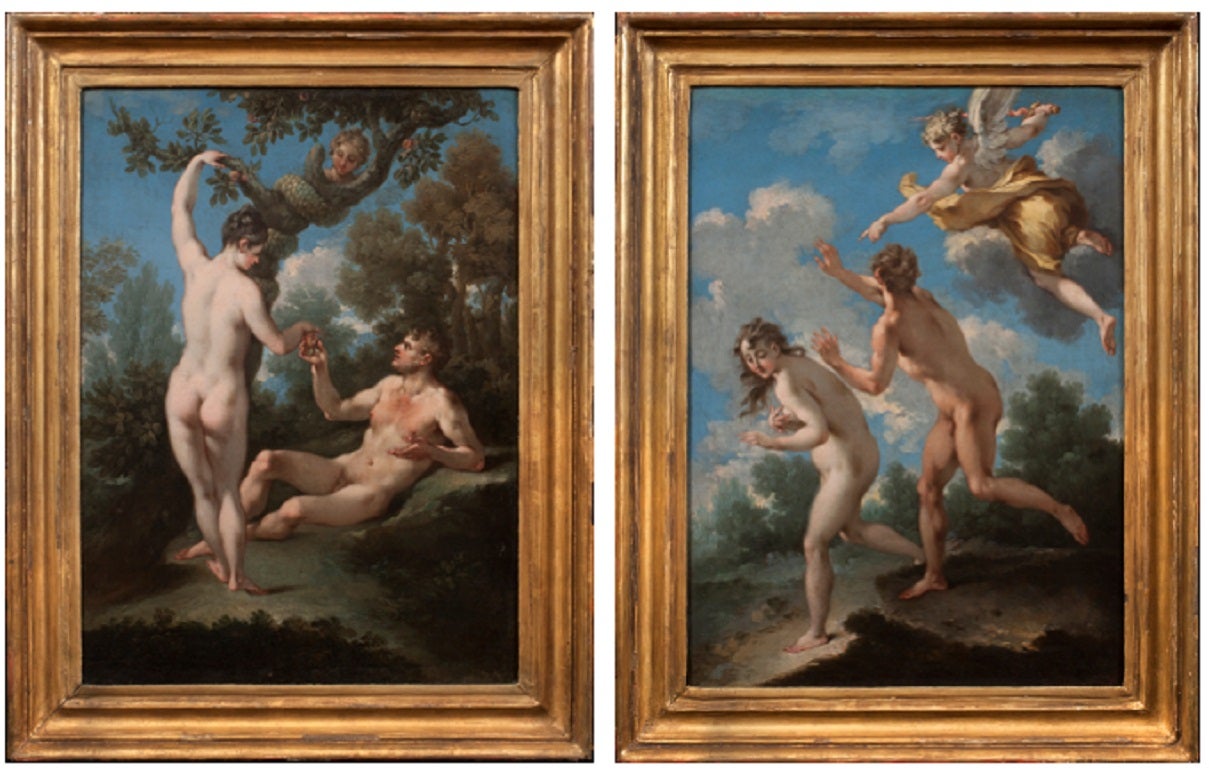
About the Seller
5.0
Recognized Seller
These prestigious sellers are industry leaders and represent the highest echelon for item quality and design.
Established in 1997
1stDibs seller since 2012
22 sales on 1stDibs
Typical response time: 20 hours
- ShippingRetrieving quote...Shipping from: New York, NY
- Return Policy
Authenticity Guarantee
In the unlikely event there’s an issue with an item’s authenticity, contact us within 1 year for a full refund. DetailsMoney-Back Guarantee
If your item is not as described, is damaged in transit, or does not arrive, contact us within 7 days for a full refund. Details24-Hour Cancellation
You have a 24-hour grace period in which to reconsider your purchase, with no questions asked.Vetted Professional Sellers
Our world-class sellers must adhere to strict standards for service and quality, maintaining the integrity of our listings.Price-Match Guarantee
If you find that a seller listed the same item for a lower price elsewhere, we’ll match it.Trusted Global Delivery
Our best-in-class carrier network provides specialized shipping options worldwide, including custom delivery.More From This Seller
View AllPortrait of an Artist (possibly a Self-Portrait)
Located in New York, NY
Provenance:
Bradley Collection.
Private Collection, Upperville, Virginia.
Literature:
Katlijne van der Stighelen and Hans Vlieghe, Rubens: Portraits of Unidentified and Newly Identified Sitters painted in Antwerp, Corpus Rubenianum Ludwig Burchard, vol. 19, pt. 3, London and Turnhout, 2021, under cat. no. 189, p. 161, and fig. 75.
This painting had previously been considered to be by an anonymous Tuscan painter of the sixteenth century in the orbit of Agnolo Bronzino. While the painting does in fact demonstrate a striking formal and compositional similarity to Bronzino’s portraits—compare the nearly identical pose of Bronzino’s Portrait of a Young Man in the Metropolitan Museum of Art (Fig. 1)—its style is completely foreign to Italian works of the period. That it is painted on an oak panel is further indication of its non-Italian origin.
This portrait can in fact be confidently attributed to the Antwerp artist Huybrecht Beuckelaer. Huybrecht, the brother of Joachim Beuckelaer, has only recently been identified as the author of a distinct body of work formerly grouped under the name of the “Monogrammist HB.” In recent studies by Kreidl, Wolters, and Bruyn his remarkable career has been delineated: from its beginnings with Joachim in the workshop of Pieter Aertsen; to his evident travels to Italy where, it has been suggested, he came into contact with Bronzino’s paintings; to his return to Antwerp, where he seems to have assisted Anthonis Mor in painting costume in portraits; to his independent work in Antwerp (where he entered the Guild of Saint Luke in 1579); and, later to his career in England where, known as “Master Hubberd,” he was patronized by the Earl of Leicester. Our painting was recently published by Dr. Katlijne van der Stighelen and Dr. Hans Vlieghe in a volume of the Corpus Rubenianum, in which they write that the painting “has a very Italian air about it and fits convincingly within [Beuckelaer’s] oeuvre.” Stighelen and Vlieghe compare the painting with Peter Paul Ruben’s early Portrait of a Man, Possibly an Architect or Geographer in the Metropolitan Museum of Art, in which the sitter holds a compass and wears a similarly styled doublet (Fig. 2).
Huybrecht both outlived and travelled further afield than his brother Joachim, who made his career primarily in Antwerp. Whereas Joachim was the main artistic inheritor of their uncle and teacher, Pieter Aertson, working in similar style and format as a specialist in large-scale genre and still-life paintings, Huybrecht clearly specialized as a painter of portraits and was greatly influenced by the foreign artists and works he encountered on his travels. His peripatetic life and his distinctly individual hand undoubtedly contributed to the fact his career and artistic output have only recently been rediscovered and reconstructed. His periods abroad seem to have overlapped with the mature phase of his brother Joachim’s career, who enrolled in the Antwerp Guild of Saint Luke much earlier than his brother, establishing himself as an independent painter in 1560. Joachim’s activity was confined to the following decade and half, and his latest work dates from the last year of his life, 1574. Our portrait was likely produced in the late 1560s, a dating supported by the dendrochronological investigation performed by Dr. Peter Klein, which established that it is painted on an oak panel with an earliest felling date of 1558 and with a fabrication date of ca. 1566.
This painting presents a portrait of an artist, almost certainly Huybrecht’s self-portrait. The young sitter is confidently posed in a striking patterned white doublet with a wide collar and an abundance of buttons. He stands with his right arm akimbo, his exaggerated hands both a trademark of Huybrecht and his brother Joachim’s art, as well as a possible reference to the “hand of the artist.” The figure peers out of the painting, interacting intimately and directly with the viewer, as we witness him posed in an interior, the tools and results of his craft visible nearby. He holds a square or ruler in his left hand, while a drawing compass...
Category
16th Century Old Masters Paintings
Materials
Oil, Panel
Portrait of a Man
Located in New York, NY
Provenance:
with Leo Blumenreich and Julius Böhler, Munich, 1924
Dr. Frederic Goldstein Oppenheimer (1881-1963), San Antonio, Texas; by whom given to:
Abraham M. Adler, New York, until 1985; thence by descent to the present owners
While old inscriptions on the verso of this panel propose its author to be Hans Holbein and the sitter Sir John More—a lawyer, judge, and the father of Sir Thomas More—this fine portrait has long been recognized to be by a Flemish hand. Max Friedländer gave the painting to Bernard van Orley (1487/1491 – 1541) in 1924, but did not include it in the volume dedicated to the artist in his Early Netherlandish Paintings...
Category
16th Century Old Masters Portrait Paintings
Materials
Oil, Panel
$52,500
Portrait of a Bewigged Gentleman
By Vittore Ghislandi
Located in New York, NY
Vittore Ghislandi, called Fra Galgario
Provenance:
Robert L. and Bertina Suida Manning, New York, ca. 1966-1996
Private Collection, USA
Exhibited:
“Eighteenth Century European Pai...
Category
18th Century Baroque Paintings
Materials
Copper
Esther in the Women's House of Ahasuerus
By Artus Wolfort
Located in New York, NY
Born in Antwerp, Artus Wolffordt received his training in Dordrecht where he became a master in 1603 at the age of twenty-two. He returned to his native city in 1615 and initially worked as an assistant to Otto van Veen...
Category
17th Century Old Masters Paintings
Materials
Oil, Panel
Two Scenes of Diana and Actaeon (a pair)
By Giovanni Battista Viola
Located in New York, NY
Provenance:
Robert L. and Bertina Suida Manning, New York, until 1996
Private Collection, USA
Giovanni Battista Viola was born in Bologna a...
Category
17th Century Baroque Landscape Paintings
Materials
Copper
Orpheus and the Animals, A Study after an Ancient Bas-Relief
Located in New York, NY
Inscribed “55” and “218” in the lower right
Watermark: Heawood 1351
Laid down on historic Cassiano Del Pozzo mount
(Mount Type A, 531 x 402 mm)
Provenance:
Commissioned by Cassiano dal Pozzo (1588–1637) for his Museo Cartaceo (Paper Museum) and kept in the library of his palazzo, via dei Chiavari, Rome
Transferred with the entire dal Pozzo collection by fidecommesso to his younger brother, Carlo Antonio dal Pozzo (1606–1689); by descent to his second son:
Gabriele dal Pozzo (d. 1695); by descent to his wife:
Anna Teresa Benzoni and after her remarriage in 1697, the Marchesa Lancellotti de’ Ginnetti (d. 1736); by descent to their son:
Cosimo Antonio dal Pozzo (d. 1740); by whom sold with the Dal Pozzo library in 1703 to:
Pope Clement XI for the Vatican Library; by whom transferred as part of the Museo Cartaceo in January 1714 to his nephew:
Cardinal Alessandro Albani (1692–1779), Palazzo ‘alle Quattro Fontane’ in Rome; by whom sold in 1762 to:
James Adam, agent for the British Royal Librarian Richard Dalton (1715–1791)
King George III of England, Buckingham House
Among the sheets of the ‘Museo Cartaceo’ appropriated by Richard Dalton during a reorganization of the drawings, circa 1786-1788; his estate sale, Greenwood’s, London, 11-19 May 1791; where acquired by:
John MacGowan...
Category
16th Century Baroque Figurative Drawings and Watercolors
Materials
Paper, Ink, Pen
You May Also Like
Old oil on Canvas 18th century , after Jean baptiste Oudry French school
Located in Gavere, BE
Very beautiful old artwork of the end of the 18th century ,after Jean Baptiste Oudry " Loup pris au piege ",
an example of which is exhibited at th...
Category
1890s French School Animal Paintings
Materials
Gold Leaf
$6,642 Sale Price
20% Off
Honden Jagen Op Een Beer (Hounds Hunting a Bear) /// Old Masters Dogs Landscape
By Abraham Hondius
Located in Saint Augustine, FL
Artist: Abraham Hondius (Dutch, c.1625-1691)
Title: "Honden Jagen Op Een Beer (Hounds Hunting a Bear)"
*Signed and dated by Hondius in the plate (printed signature) lower right
Year...
Category
1670s Old Masters Animal Prints
Materials
Laid Paper, Etching, Intaglio
19th Century German Oil Painting
Located in Tampa, FL
Anton Passinger was an Austrian artist born in 1825. He died in 1900. The name is anglicized on the brass plaque, and it’s signed with his German signature on the back. The painting ...
Category
Antique 1890s German Paintings
Materials
Paint
Study of a dog
Located in Amsterdam, NL
Study of a dog
Oil on paper laid down on panel, 17.5 x 25.5 cm
Provenance
Private collection, the Netherlands
Note:
We are grateful to Mr Fred Meijer for his attribution to Ludolf de Jongh
Ludolf de Jongh was the son of a shoemaker. When his father moved to Rotterdam, the young Ludolf decided to learn art rather than shoemaking and became a pupil of Cornelis Saftleven. Later he studied under Anthony Palamedes in Delft and still later with Jan van Bijlert in Utrecht.
In 1635 he travelled to France with Francis Bacon. Seven years later, in 1642, he returned to the Netherlands when he heard that his mother had fallen ill. He set up a shop in Rotterdam, and his earliest signed paintings date from that year.
According to Houbraken, his travels had caused him to speak French so fluently, that his parents had to learn French in order to speak with him.
De Jongh’s work shows a strong influence from the Utrecht school of Caravaggio admirers, especially Jacob Duck...
Category
Mid-17th Century Old Masters Animal Paintings
Materials
Paper, Oil, Wood Panel
A Wolf, Hand-Colored Print From The Early 1800s by Johan Wilhelm Palmstruch
By Johan Wilhelm Palmstruch
Located in Stockholm, SE
Johan Wilhelm Palmstruch (1770-1811) Sweden
Title: A Wolf
hand-coloured print
early 1800s
print dimensions approx 4.33 x 7.08 inches (11 x 18 cm)
frame 11.81 x 15.74 inches (30 ...
Category
Early 19th Century Naturalistic Animal Prints
Materials
Etching
17th Century Flemish School, Wild Boar Hunt in the Style of Frans Snijders
Located in Leuven , BE
17th century Flemish Shool Antwerp, wild boar hunt in the style of Frans Snijders, oil on oak panel marked by Guilliam Gabron 1609-1662, Antwerp. The st...
Category
Antique 17th Century Belgian Paintings
Materials
Paint
More Ways To Browse
Animals Fighting
Carlo Painter
Snyders Antique
Mare And Foal
Oil Paintings Animals Africa
Pheasant Oil Painting
Ford Walton
Horse Head Painting
Linda St Clair
Mallard Painting
Mt Washington
Realism Wildlife Paintings
Spaniel Dog Paintings
Trout Painting
Zebra Oil Painting
Barton Oil Painting
Flamingo Oil Painting
Jansen Oil
